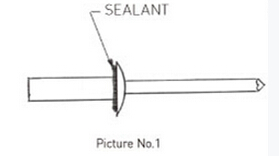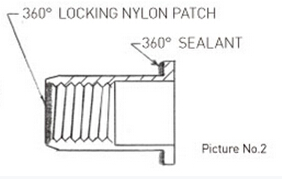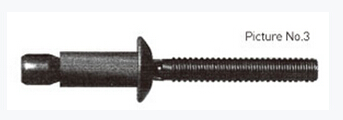
Privacy statement: Your privacy is very important to Us. Our company promises not to disclose your personal information to any external company with out your explicit permission.
2014 was an important and active year for blind rivets (blind rivets). I also received more inquiries and application questions about blind rivets (blind rivets). I also saw an increase in the use of blind rivets (blind rivets) and an increase of 8% in sales. Sales, use and innovation are very active.
Closed blind rivet (blind rivet)
The sealant for blind rivets (blind rivets) increases the frequency at which blind rivets (blind rivets) are applied to liquids and gases. The use of sealant blind rivets (blind rivets) increases the use of latching blind rivets (blind rivets) in watertight and airtight applications.

Through the center of the rivet body, the blind blind rivet (blind rivet) can achieve watertight and airtight effects because the rivet body is latched on the upset side. The sealant applied to the flange side of the flange creates a hole, and then the latching blind rivet (blind rivet) is implanted to achieve watertightness and airtightness, because when the lock nut blind rivet (blind rivet) After being placed, the sealant seals the holes in the workpiece.
When the sunroof and other objects are nailed into the truck body, water leakage may occur on the top and side of the truck. Closed blind rivets with sealant (blind rivets) have successfully solved this problem. These sealant blind rivets (blind rivets) are used for canoes or other water recreation floats, while others are used for windshield doors and windows. Gas is filled into the two joined glass sheets, and the blind blind rivets (blind rivets) with sealant can also solve the problem of air leakage.
Sealants are available in a variety of hardness grades and are very easy to select for the blind rivet (blind rivet) hardness for your application. Household appliances such as dishwashers and washing machines now have latching blind rivets (blind rivets) with sealants.
Thread insert
Thread inserts have also been improved in design and use.

Threaded inserts have been introduced into two important and useful innovative designs. A nylon anti-loose patch placed on the first thread allows the coupled threaded fastener to vibrate without loosening. This threaded nylon anti-loose patch does not interfere with the design of the threaded insert. The threaded pull mandrel is a nylon lock that is fitted to engage the threaded insert to the first thread. This still allows for sufficient thread engagement of the threaded mandrel to pull and install the threaded insert without thread wear.
The vibration test has already had good results. For 1/4-20 threaded inserts with single threaded nylon anti-loose patches with hex head bolts grade 5 galvanized steel fasteners. The standard torque test after the vibration test has been completed and the following results have been obtained:
The first time to remove the static minimum 14 inch pounds
The second time to remove the static minimum 13 inch pounds
Remove the static minimum 10 inch pounds for the third time
The fourth time to remove the static minimum 8 inch pounds
The fifth time to remove the static minimum 7 inch pounds
Except for the absence of a clamping force, the tests were carried out as described in paragraph 5.3.1 of IFI-100/107. "Vibration test", the load is applied and each threaded coupling is combined with the same number of threads onto the insert with (or without) a single threaded patch. The vibration test showed that all of the uninsulated thread inserts showed signs of retraction, and all inserts containing the anti-loose patch did not retract.
The anti-loose patch allows the coupling screw to be more stable and the vibration does not affect the combined action. The anti-loose nylon patch is a very good innovation in the assembly plant.
Sealants have also been applied to threaded inserts. The sealant allows the installed thread insert to create no water leakage on the workpiece, which has solved the problem of liquid leakage on the truck body and in many outdoor applications.
Structural blind rivet (blind rivet)

Structural blind rivets (blind rivets) have also been improved in use. Some companies that produce structural rivets with diameters of 3/16 (4.76 mm) and 1/4 (6.35 mm) have also extended the production of the product line to 3/8 (9.52 mm) structural blind rivets (blind rivets). Because blind rivets (blind rivets) are very easy to install and can be set during the manufacturing process using power tools, the use of this product has increased and users have demanded higher shear and pull values. When using solid rivets, the workpiece must be supported by a solid rivet mounter, but blind rivet (blind rivet) installation tools can be applied directly on the production line, and blind rivets (blind rivets) can be installed during production line operation. . Structural 3/8 (9.52 mm) structural blind rivets (blind rivets) can produce more than 6,000 pounds (26,689 Newtons) of shear and more than 4,000 pounds (17,792 Newtons) of tension.
In 2014, the use of blind rivets (blind rivets) has increased, design innovations have emerged, and manufacturers of blind rivets (blind rivets) have reached the level required by users. (Source: Author: United States / Anthony Di Maio Fastener Info consolidate)
Related recommendations: Blind rivet supplier recommended
View standard data of blind rivets at home and abroad
April 07, 2023
October 17, 2022
October 12, 2022
E-mail naar dit bedrijf
April 07, 2023
October 17, 2022
October 12, 2022

Privacy statement: Your privacy is very important to Us. Our company promises not to disclose your personal information to any external company with out your explicit permission.

Fill in more information so that we can get in touch with you faster
Privacy statement: Your privacy is very important to Us. Our company promises not to disclose your personal information to any external company with out your explicit permission.